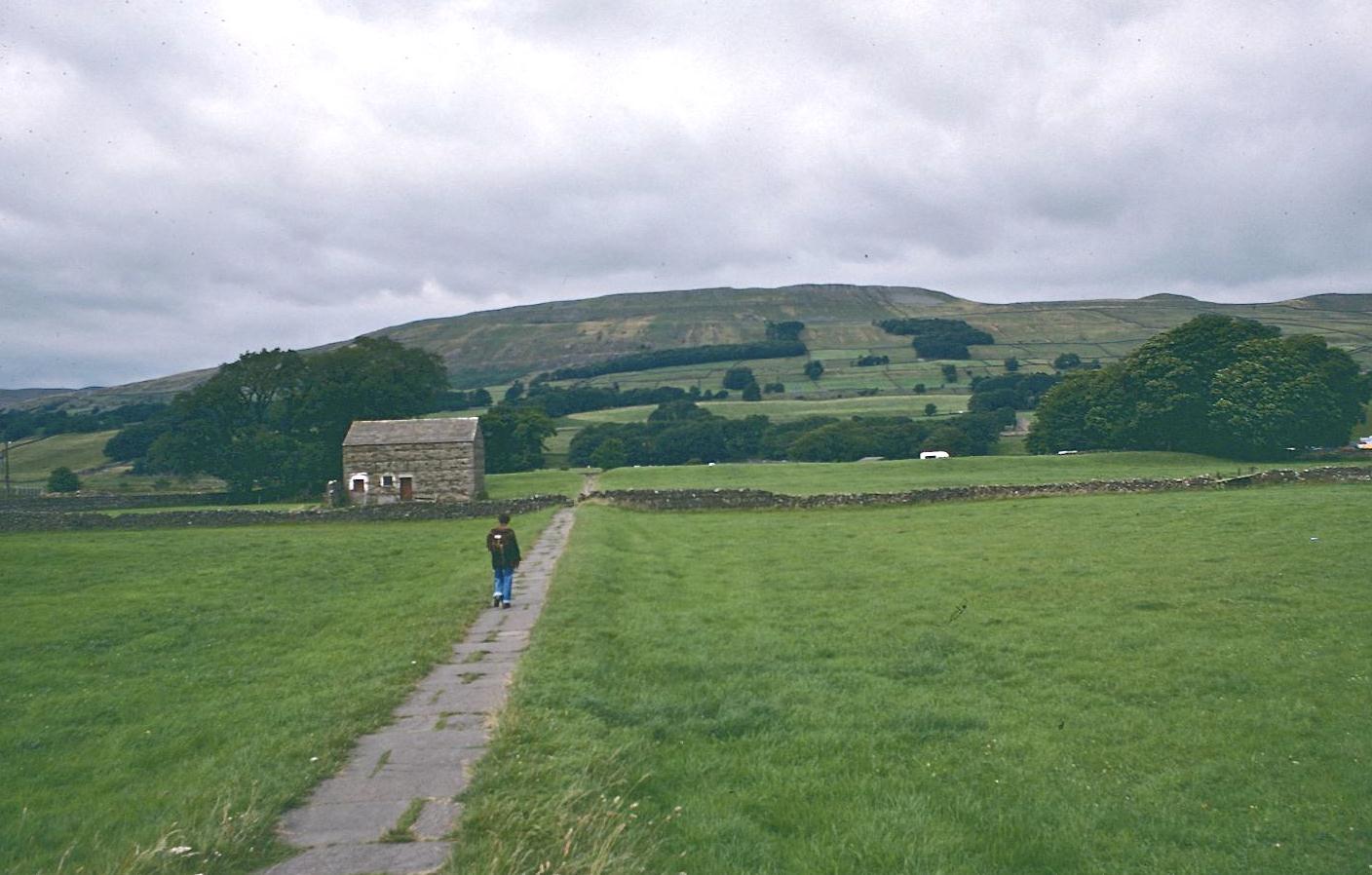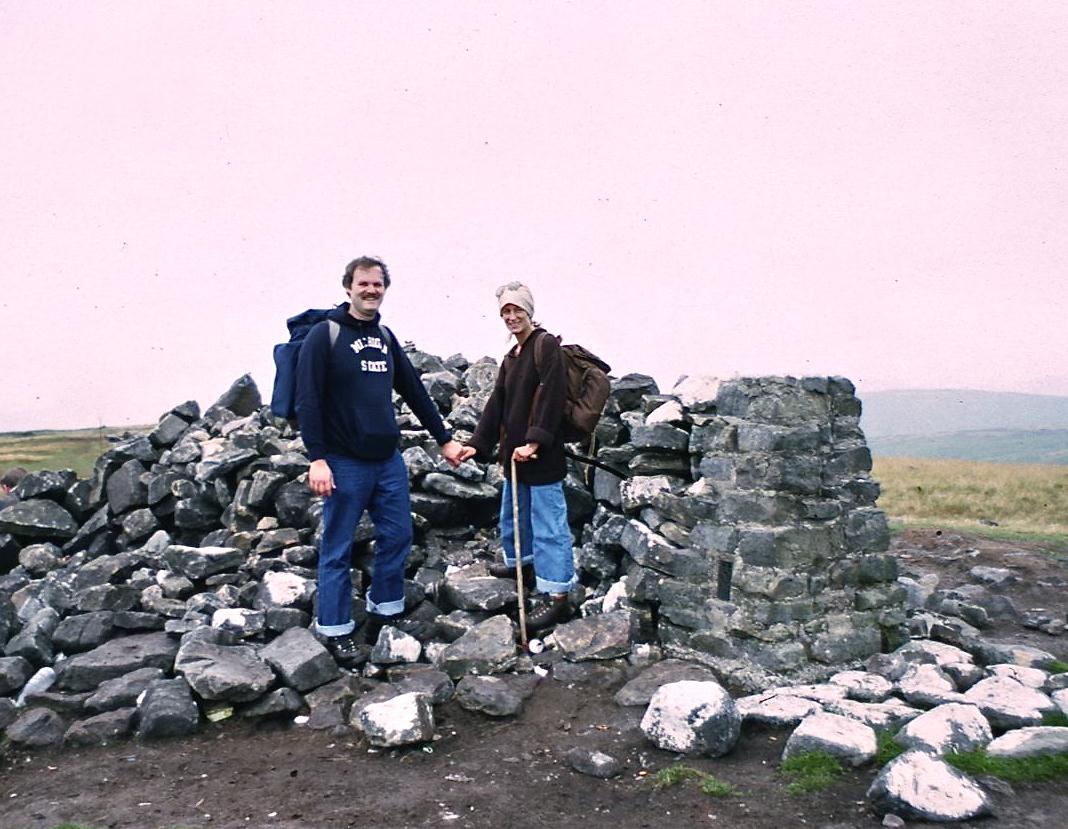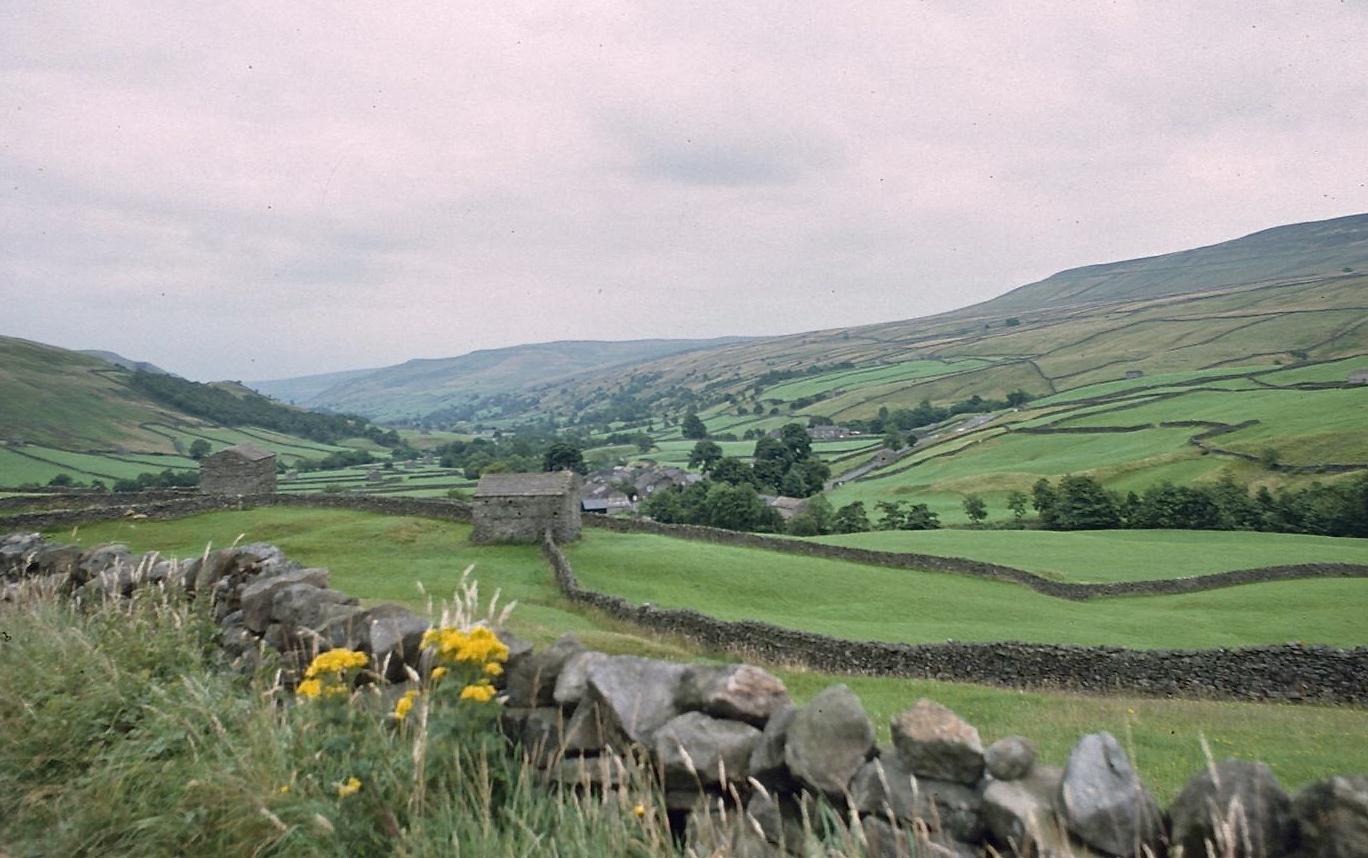August 6, 1976: Hardrow To Keld

Dorothy on the flagstone path near the Haylands Bridge
– as we begin another expedition on the Pennine Way
Two years passed before I was able to mount a second Pennine expedition. In the months that had followed my defeat, in August of 1974, I had squandered an inordinate amount of time on self-recrimination and doubt. Success in an activity so technically simple, yet so challenging and full of unsuspected peril, now became a test of my happiness, a measure of my self-worth. Obsessively I turned the pages of my slightly sodden copy of Wainwright, fretting over problems I must still encounter and glorying in the beauty I still had coming to me in the next sections of the route. The flat woodlands of central Michigan, the huge empty fields and the suburban spread, never regained their charm for me, not when I could compare my home environment with the abstract values of the English countryside, that picturesque medley of fell, lonely farm and dry stone wall. To each of the corners on the tree-lined streets of our East Lansing neighborhood I attributed the name of a Pennine setting – so that my progress at the end of our Old English Sheep Dog’s lead brought me each evening to all those magical end of day place names – those of 1974 and those I looked forward to reaching in my dream itinerary of the future. How many times did Ozzie lumber through Malham, lift a leg on Horton’s fire hydrant, bump into the telephone pole that represented Hardrow once again. (This tiny village appears as “Hardraw” in many versions, I might add; Wainwright had spelled it “Hardrow.”)
My obsession reached its apogee in the weeks preceding the second expedition itself. As each of the bed and breakfast reservations came in from distant Pennine landladies my excitement grew. I was determined to do everything that could be done on my side of the Atlantic to facilitate the success of this year’s outing. This resolve went far beyond a scrutiny of timetables, guidebooks and OS maps. For a month or so I went on conditioning hikes in the humid woods of nearby Rose Lake. I dragged the dog along on some of these walks too, but the huge shambling creature was soon worn out by my pace and kept throwing himself into every available rain puddle. At home, with the memory of my leg problems ever near, I did deep knee bends.
A new recruit was enlisted for this summer’s trek, my wife Dorothy. Dorothy would have been classified as a non-walker before this point and I was immensely excited to have her participation. Something of my enthusiasm for the delights of the English countryside must have rubbed off; either that or she felt someone must keep an eye on her disaster-prone husband. In agreeing to undertake so strenuous a regime she was clearly breaking a long-standing promise never to walk farther than the length of a suburban shopping mall. I also appreciated the good spirit with which she accepted each item of spectacularly unchic rambler’s outerwear, an ensemble of heavy boots, rubbery rain pants and burdensome knapsack – the latest in bas-couture. I never won her participation in my steamy conditioning walks and there was no way she would consent to clump across our carpet in her new vibram soles, but nightly I could hear the whirr of her rope pulleys as she did her leg-stretching exercises against the bedroom doorknob.
This vacation trip to England was to last three weeks and we had agreed to divide the time roughly between London and the North. Only a week before our departure I was attacked by a swelling in my right instep. Perhaps my own new boots were to blame – it took me a while to discover that the insertion of a thin arch support was necessary for full comfort. Naturally I was overwhelmed with despair, fearing that the foot would never recover in time for walking. I abandoned my cane only on the day we climbed aboard our plane. Thereafter I tested the foot gingerly on the pavements of Chelsea; it grew weary before it should – but there was no recurrence of the swelling and I was certain I could begin after all.
We left cousin Bernard’s flat in Knightsbridge at 8:15 on the morning of Thursday, August 5. I tried to take some pictures of Dorothy in front of Harrods but my light meter was failing. We took the tube to Kings Cross and found our seats – well we found one – claiming the other required the displacement of a Swedish father from the rest of his family but, after all, I had paid 40p for these reservations on Lower Regent Street. Anyway our seats faced backwards, which I hate. The journey up to Darlington was uneventful. We took a cab to the bus terminal, arriving fifteen minutes before our next departure time. Both the cab driver and the kiosk lady, who cashed a ten pound note and sold me some Polo mints, wished us a good journey. It was warm in the bus and after we had changed in Richmond I took off my M.S.U. sweatshirt. The drive up Swaledale and Wensleydale was beautiful as usual, and it felt so good to be here with my wife – after having endured such a solitary exploration two years earlier. In Leyburn, in particular, it was quite satisfying to sit at the back of the bus and see all the sights of August, 1974 and not get off and go to my lonely room at Mrs. Hudspeth’s, where I had spent several days at the conclusion of that disappointing summer. We had been traveling some two and a half hours from Darlington when we finally arrived at Hawes market place.
Neither of us enjoyed the first bite of the pack weight on our backs, but we strode along purposefully, stopping for some postcards, some pop, and some stamps. I took a number of photographs as we slowly made our way over the Haylands Bridge and along the Pennine Way to Hardrow: Dorothy standing in front of the Conservative Club, Dorothy alone on the flagged path up to the Ure, Dorothy posing insouciantly on a stile. There were sunny intervals mixed into the cloudy skies but the weather was pleasant and unthreatening. My foot seemed to be holding up all right.
One of the Shay sisters remembered me when we got to the Green Dragon, where we unpacked a little and walked around some, visiting the falls and strolling along past the little village school. I took the rest of a twenty-exposure roll of film and we both had a bath. Drinks in the pub and a filling evening meal in the dining room followed. The day had been so perfect and untraumatic and Dorothy such a good companion, even in such unfamiliar circumstances, that I could not have been more delighted by this first installment in our great adventure. What follows is a record of what happened on August 6, 1976, a Friday.
It was quite gray on this morning and I had visions of another wet ascent of Great Shunner Fell. We had the usual excellent breakfast and I picked up our lunch and paid (the rather steep) Green Dragon bill. The staff brought sandwiches in rolls, two apples and some cake for our lunches, but no sack to put these items into – and I ended up squeezing all these things into the front pouch of my M.S.U. sweatshirt until I could get back to our room and finish adjusting my pack.
The light meter wasn’t working on the camera again and this was a disturbing note – I had to guess at all the exposures and there were a few disasters, though I suppose things turned out better than I thought they would when the day’s roll was finally developed. Dorothy also had initial difficulties – with her boots, whose ankle bindings were chafing her calves. She stuffed some toilet tissue and Kleenex into the gaps between boot and flesh but this paper had a tendency to work lose and fall out. This meant that even before our first ascent of Bluebell Hill we had to stop several times for re-stuffing.
The earliest stages of the climb are, of course, the steepest, but we seemed to be doing fairly well. I was pleased by our time and by our pace. There were only a few other walkers about and a farmer in a land rover who paused to joke about the superiority of his method of travel to our own – his refined accents were not those of the Green Dragon pub-goers, whose patois had baffled me two years earlier. At one gate we waited to admire a feminine trio who, it turned out, were undertaking the entire Pennine Way in one go. I was bowled over with admiration. “I see you’re carrying Wainwright’s Pennine Way Companion,” I said, “the Bible of this trail.” They smiled politely and charged up the hill ahead of us on well-muscled legs. We did not pause until the two-mile mark, when we sat down for ten minutes and Dorothy smoked a cigarette while I stuck my hand in a nettle bush.
Perhaps there was a distant peal of thunder. The summit was shrouded in clouds and I was convinced that we would eventually get wet, but except for one or two flecks of mist, none of these predictions materialized. It was, in retrospect, ideal hiking weather.
I was having my first real glimpse of the upper slopes of Great Shunner Fell, for visibility had been so poor in 1974 that I hadn’t seen more than a few feet ahead of me. I was enjoying myself tremendously and one element in this satisfaction was the absence of those slimy impediments, the peat hags, which had sucked so at my boots two summers earlier. One could see the almost fossilized imprints of hikers’ boots dried into the soil, but the lack of moisture in this famously dry summer made passage through these heaving plains easy. Even the stream, which I remembered as the three-mile mark, was gone. Instead the eroded tussocks bore the names of English teenagers spelled out in loose white stones.
We could see the red jackets of other hikers hunkered down at the summit cairn as we ourselves plodded up the last few feet. We reached the summit, ahead of schedule, at 12:05. The girls we had met earlier were still here and one of them took our picture with my camera. A sour dad and mom plus a lot of rambunctious kids were sitting on the summit stones. We ate a little lunch while naughty sheep cadged handouts. It was windy and a bit chilly but there was some shelter up against the cairn. For a few minutes we were all alone and I stood guard while Dorothy ducked down for a pee.
We began the descent around 12:30. Much of this was quite steep and marked by interesting cairns and some beautiful views. There was even one small rise to struggle up. A number of hikers were coming up as we climbed down; one set was accompanied by two dogs, including a Bearded Collie. I chewed some bubble gum.
We had a rest atop the spoil heap near the trial level, with Thwaite below us. The cobbled road that leads downward was a sore trial for our feet – a hard surface after the cushioning fell, uneven after the smooth groove worn into the turf by a thousand well-shod feet. Dorothy began muttering about these discomfitures and it was a relief to reach Thwaite’s tarmac at about 2:40.
We wandered around the dining room of the Kearton Guest House, trying to discover if tea were being served, but since it was not, we settled for some lemon soda purchased at the adjacent store. This we drank outside while writing some postcards. At 3:00 or so we donned our packs again and trudged across some fields and up a steep path to begin the walk around Kisdon. I felt Dorothy was doing very well out in the lead, setting a nice and steady pace. Views back to Thwaite and down Swaledale were excellent. We rounded Kisdon farm and cottage and began moving north along the “limestone shelf,” which again proved to be very rocky and uneven underfoot – the path itself dipping up and down amid stolid cows (whom we had to circumvent) and through narrow wall styles.
Dorothy called a halt here to examine her feet, which had become increasingly hot and uncomfortable. When the boots came off and socks as well it was possible to see what all these rough surfaces had done to the reddened soles of her feet. On the insteps of each sole was a wallet-sized blister of luscious proportions. Her ankles were also very swollen from the abrasion of the boot tops. Perhaps the time of month had also contributed to this painful condition. It seemed inconceivable to me that she had not experienced severe discomfort from such punishment long before this moment, when so much damage had already been done. Briefly it had crossed my mind that she had hidden the true state of her distress from me so as not to disappoint my expectations. I also recalled all those unheeded entreaties to break in these boots back in East Lansing, a neglect that had resulted in the fateful dividend we now saw before us. I thought of all these things, but I said nothing. What was the use of recriminations at this point? Fortunately we had just an hour or so to go now – but I knew already, as my wife struggled into her boots one last time, that Dorothy’s Pennine Way adventure was over, and with it, very likely, my dreams for another year.
We didn’t discuss any of this up by North Gang Scar. Dorothy put some tape on her feet and we shuffled down to Keld. There were dozens of people about on the trails now. In the village I sent Dorothy into the post office to enquire about bus schedules on the morrow. Then we walked slowly back toward Thwaite on tarmac and located the path up to Woodside Cottage. A last shot of Dorothy approaching the front door shows her giving the photographer the bird. It was about 5:45 – very near our original projected arrival time.
Mrs. Calvert proved to be an excellent hostess and our room was quite nice. There was a beautiful view of Kisdon and, directly below, Mrs. C.’s flower garden – which bloomed, even in a dry summer, due to the irrigation provided by the left over washing-up water. Dorothy and I each had time for a quick bath before a dinner of pork cutlets, potatoes, and veg. Our dining companions included a couple from the south and their college-aged daughter, just completing a two week stay with Mrs. Calvert. They were very nice and offered various treatment suggestions for Dorothy’s blisters.
In our room I attempted to fix the light meter as I changed the day’s roll of film. To Dorothy I explained a series of options now available to us. These included my continuation to the next stop, Bowes, alone – with Dorothy attempting to follow by public transport; my accompanying Dorothy to the same site by public transport – and to the next few stops on the list as we looked for some improvement in her feet; and our both returning to London the next day. Dorothy was not enthusiastic about the first two ideas and when the boyfriend of the family’s daughter showed up to discuss mutual departure plans (they had two cars) I began to sound him out about a ride to Richmond. As darkness descended we sat around in Mrs. C’s living room and had a nice chat while Dorothy soaked her feet.
In spite of my unhappiness over the cancellation of this year’s Pennine plans I slept well and got us ready, after breakfast, for our return to London. Dorothy was intensely regretful over having spoiled this project and this, her promise to return the next year, and the realization that we had been having a grand time in London, served to soothe my sorrow. Nevertheless I felt a sense of shock in this hasty retreat.
When our friends dropped us off in Richmond I changed some money at a travel agent and we hopped a bus for Darlington. I lost a little filling to my bubble gum and spent some time trying to flush it out with some floss at the train station while Dorothy phoned in our cancellations to the next four landladies – the rest got postcards written on the train and mailed on our arrival in London. The train ride itself was tedious, the carriage crowded and filthy. Moreover the train was bulging with Dutch Boy Scouts. We were back in Kings Cross before 6:00 and Bernard’s empty flat soon welcomed us; it was unchanged after so short an interval Throughout the remainder or our stay in England, which I endeavored to make as pleasant as possible, I never again alluded to the profound disappointment which I carried within me, nor, expect for these remarks here, have I ever done so since.
To continue with the next stage of our walk you need:


